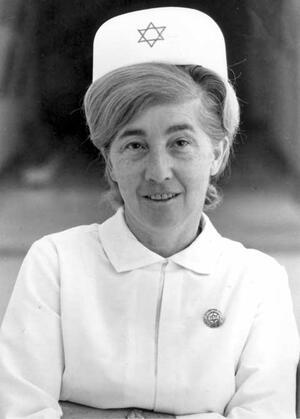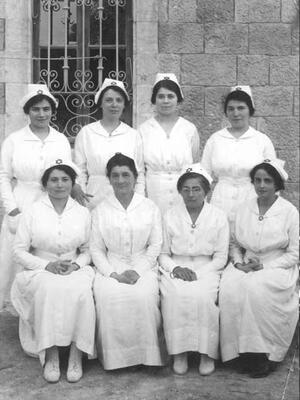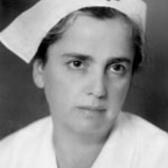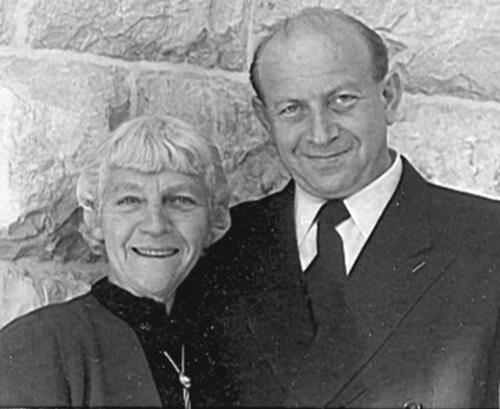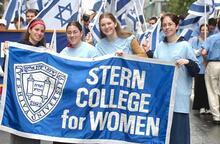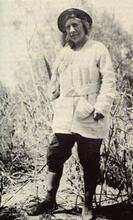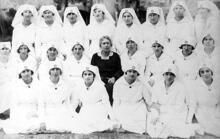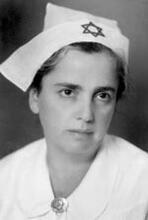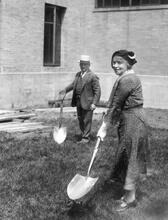Hadassah School of Nursing: First Graduating Class
Judith Steiner-Freud, a graduate of the Henrietta Szold Hadassah School of Nursing, became the director of her alma mater, as well as Deputy Dean of nursing in the medical faculty of Hadassah and the Hebrew University of Jerusalem, and thus had an important influence on the development of nursing education and practice in Israel.
Courtesy of Judith Steiner-Freud
Nursing was not recognized as a profession in Israel until 1918, when the American Zionist Medical Unit, which later became the Hadassah Medical Organization, opened a nursing school. The group of young women accepted for the first class included women from various areas and population groups in the country. These new women students decided to learn a profession that would allow them to live independent lives and contribute to the country. In the context of the time and place, these young women on their own, who aspired to a just society, were suspect. Yet the first graduates quickly showed the kind of leadership that would spearhead the development of the nursing profession.
Nursing in Israel
A study of the first twenty-two graduates of the Henrietta Szold Hadassah-Hebrew University School of Nursing reveals that many of them laid the foundations of the nursing profession in Palestine.
Nursing was not recognized as a profession in Palestine until 1918, when the American Zionist Medical Unit, which later became the Hadassah Medical Organization, opened a nursing school. The group of young women accepted for the first class included women from various areas and population groups in the country: immigrants from Eastern Europe and native-born women, daughters of orchard farmers, founders of the first Cooperative smallholder's village in Erez Israel combining some of the features of both cooperative and private farming.moshavot and pioneers who, together with men, drained swamps and built roads. These new women students decided to learn a profession that would allow them to live independent lives and contribute to the country.
In the context of the time and place, these young women on their own, who aspired to a just society, were suspect. Yet the first graduates quickly showed the kind of leadership that would spearhead the development of the nursing profession.
Overview of the Graduates
The graduates were Yehudit Alkalay, Tzippora Ashkenazy-Azoulay, Shoshanna Braz-Yefet, Peninah Buchstetter, Shifra Chaikin-Rosy, Sarah Hankin-Tesker, Dina Heller, Tsippora Horenstein, Hanna Katznelson-Nesher, Helena Kissin-Goldstein, Esther Litvinovsky-Dayan, Tova Pastersky, Rachel Pesach-Rosenberg, Penina Radofsky, Tsippora Sabora’it-Ediger, Leah Satanovsky, Hadassah Schedrovitzky-Sapir, Sarah Shabtai-Shitrit, Tikva Weinstein-Yalouz, Rivka Wolkenstein-Ezer, Rivka Yerushalmi-Cohen, and Chaja Zaslavsky-Kopilevitch.
All were born between 1893 and 1901. When they began their studies, most of them were between seventeen and twenty-two years old. Ten of them had been born in Palestine, eleven in countries that belong to the CIS (Confederation of Independent States) of today, who had immigrated during the Second [jwa_encyclopedia_glossary:293]Aliyah[jwa_encyclopedia_glossary] (1904–1914). Seven of them graduated from gymnasia in CIS countries, and three from agricultural schools in Palestine. A survey conducted in the 1980s found that eleven of the graduates were married, one was widowed and two divorced. Seven were unmarried. Of those who were married, seven were mothers and all of them combined had thirteen children. Biographical details of one of the graduates are unknown.
At the conclusion of their studies, the graduates were sent to work in Hadassah hospitals in Jaffa (which moved to Tel Aviv in 1926), Jerusalem, Safed, Tiberias and Haifa. Two graduates were appointed as head nurses in the hospitals in Tiberias and Jaffa respectively.
A look at the graduates in 1944, twenty-three years after they finished their studies, shows that two of them were supervisors in nursing care in Hadassah University Hospital on Mount Scopus (Shifra Chaikin-Rosy among them); two served during various periods as nursing administrators in the Hadassah City Hospital in Tel Aviv. Three had management positions in public health and two were social workers in Jerusalem (among them Hanna Katznelson-Nesher, sister of Berl Katznelson, 1887–1944, the leader of the Zionist Labor movement). One nurse, Sarah Shabtai-Shitrit, left to raise a family after some twenty years of nursing care management. Her husband, Behor, held a senior position in the Jewish community’s Mandate-era emerging justice system and later served as Minister of Police (1948–1967). Shoshanah Brez-Yefet left the nursing profession to assist her husband Hayyim Yefet (1900–1985). Yefet was one of the pioneers who laid the foundations for social work during the Mandate period. Three graduates lived abroad, including Yehudit Alkalay, who earned a doctorate in health education from New York University. Four of the graduates had died.
Biographies
The following are brief histories of four of the graduates:
Rivka Wolkenstein-Ezer was a leading figure in hospital nursing care management. For more than twenty-five years she directed nursing care at the Hadassah Tel Aviv City Hospital, today Ichilov Hospital, and at the nursing school founded in 1943. In 1950, Wolkstein-Ezer directed the nursing department at the Ministry of Health for one year.
Chaja Zaslavsky-Kopilevitch was a leader in community nursing services. She received additional training in public health at the Hadassah Nursing School in Jerusalem and at the end of 1927 she supervised the Hadassah health clinics in Tel Aviv, Rehovot and Petah Tikvah. At the beginning of 1930 she returned to Jerusalem and was appointed chief supervisory nurse of the Hadassah health clinics throughout the country. From 1948 to 1952 she was a public health supervisor for the Tel Aviv Municipality and the Ministry of Health.
From the 1920s to the 1940s Shifra Chaikin-Rosy was the head nurse in the internal medicine department at Hadassah Hospital in Jerusalem, assistant to Shulamith Cantor, a supervisor and teacher in the nursing school and responsible for Hadassah’s outpatient clinic. When the state was founded, Chaikin was the director of nursing services and the nursing school at the Ha-Yarkon government hospital in Tel Aviv. At the beginning of the 1930s she prepared texts on internal nursing, thus laying the foundations for the knowledge of nursing. These texts were important for teaching students at the nursing school.
Hadassah Schedrovitzky-Sapir was prominent in the field of nursing education in Israel. She was a distinguished student, chosen from among twenty-two students to study at the Teachers’ College at Columbia University, New York, in 1922 and 1923. Following this training, and together with Anna Kaplan, Schedrovitzky-Sapir made reforms in the school’s curriculum. Beginning in 1924, Schedrovitzky-Sapir taught nursing care at the school. When Kaplan left the country in 1927 Schedrovitzky-Sapir, under the supervision of Bertha Landsman, directed the work of the nurses at Jerusalem’s Hadassah Hospital and in the nursing school. She left Hadassah in 1933.
In 1936, when the General Sick Fund opened its first nursing school in the Jezreel Valley (it later moved to Petah Tikvah), Schedrovitzky-Sapir took on a central role. In 1939–1940 she directed a course for practical nurses in Tel Aviv, which led to certification. In 1947 she helped found the Israel Nurses’ Association and in 1949 founded a practical nursing school at the Zahalon Hospital in Jaffa.
Hebrew
Bartal, Nira. “Theoretical and Practical Training of Nurses in Mandatory Palestine, 1918–1948, through the Prism of the Hadassah School of Nursing, Jerusalem.” Ph. D. diss., Hebrew University, Jerusalem, 2000.
Katznelson-Nesher, Hannah. Brother and Sister: A Memoir. Tel Aviv: 1978.
Schedrovitzky-Sapir, Hadassah. “The Hadassah Nursing School: Its Founding and Times, 1918–1932.” The Archives of Hadassah and Hebrew University Henrietta Szold Nursing School, Jerusalem.
Idem. “An Account of the Changes in the Nursing School in 1924.” The Hadassah and Hebrew University Henrietta Szold Nursing School, Jerusalem.
Central Zionist Archive (J117); Steiner-Freud, Judith, and Sarah Levi. “Hadassah Schedrovitzky-Sapir.” The Nurse in Israel 49 (May 1995).
English
Bartal, Nira, and Judith Steiner-Freud. The First Graduating Class, Hadassah School of Nursing, 1921. Jerusalem: 1999.
Kaplan, Anna. “Report of the First Commencement of the Hadassah Training School for Nurses, Jerusalem, Palestine.” Hadassah Archives in New York, Hadassah Medical Association, Box 45, File 4, 1921 (?).
Idem. “Annual Report of the Hadassah Training School for Nurses, Hadassah Medical Organization, Jerusalem, Palestine, for the Year 1925.” Rose Jacobs Archive, Central Zionist Archive, Jerusalem. (A375/235).
Zwanger, Lea. “Preparation of Graduate Nurses in Israel, 1918–1965.” Ph. D. diss., Columbia University, New York: 1968.

